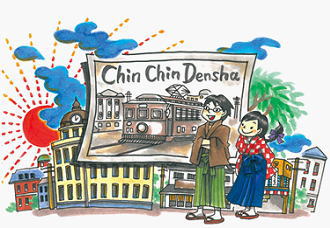Hakata Culture vol.50
Streetcars and the streets of Hakata

Nishitetsu operated streetcars―onomatopoetically dubbed chinchin densha by the locals―in Fukuoka City from March 1910 until 1979. The ceremony marking the opening of the line was held on March 9 that year and operations began the next day. The Fukuhaka Denki Kido, operated the line, and it was created by Momosuke Fukuzawa, the adopted son of Yukichi Fukuzawa, the founder of Keio University and the man whose face appears on the ¥10,000 note, and Yasuzaemon Matsunaga, who later became known as a power company magnate.
The work to launch the line was expedited to coincide with the March 1910 opening of an expo known as the 13th Kyushu-Okinawa Eight Prefecture Confederated Exhibition. The line ran for 5.6 kilometers from the terminal stop in front of the Hakata Station’s location at that time, through Gofuku-machi and Hakozaki, where Kyushu University was located, to Nishi Park. The fare for each segment of the trip was two sen―one sen for the fare itself and one sen as tax.
For some perspective on what was happening in Fukuoka and Japan at that time, the Kyushu Imperial University opened in 1911. It is surprising that the Kyushu Philharmonic, Japan’s first amateur orchestra, was founded in the same year.
The route was extended in 1911 from Hakata Station through Tenjin (then known as Tenjin no Cho) to the stock exchange. A loop line was created in 1914 with the opening of the leg from Chiyomachi to Hakata Station. The creation of this streetcar line was the trigger for the development of Tenjin no Cho. Until then, Gofuku-machi and Kawabata-machi were the city’s primary commercial districts. The municipal offices were located in Tenjin, but it was some distance away from the centers of commerce. During this period of great change Fukuoka City took a giant step toward modernization with the exposition and the opening of the subway line. Transportation networks have always had the capacity to transform a city.
Traces of the chinchin densha can still be seen in the city. The bus stop on Maidashi-dori near the Kyushu University Hakozaki campus was the streetcar stop 100 years ago. The location is marked by the rectangular granite slabs one sees after getting off the bus at that stop. Though they’re overshadowed by the eaves of residential dwellings, it’s worth a trip to see the place from which streetcars departed for Hakata Station a century ago.
九州新幹線が全線開通する3月 路面電車も産声をあげていました
福岡市の町には1979年まで、西鉄が運営する路面電車、通称・チンチン電車が走っていました。このチンチン電車、福岡市内を初めて走ったのが、1910年(明治43年)3月9日といわれています。この日は開通式で、翌日の10日から営業運転したようです。電車を走らせたのは、福博電気軌道。創設者は慶應義塾大学をつくった福沢諭吉の養子であった福沢桃介と、後に電力王や電力の鬼と呼ばれた松永安左エ門(やすざえもん)。同年3月、現在の天神で行われた「第13回九州沖縄八県連合共進会」という博覧会の開催に間に合うようにと急いだのです。博多停車場前(当時の博多駅)から呉服町、箱崎の九州大学前から西公園間、全長5.6キロの路線で開業しました。当時の運賃は1区1銭、それに通行税が1銭で計2銭でした。ちなみに、九州帝国大学が発足したのは1911年のことです。我が国初めてのアマチュアオーケストラ・九大フィルハーモニーが創立されたのも同年というのは驚きです。
1911年には、博多駅前から天神町(昔の天神は「てんじんのちょう」と呼ばれていました)を経由して取引所前が開通し、1914年に千代町から博多駅前が開通して、循環線と呼ばれた路面電車網が完成しました。この電車が開業したからこそ、天神の町は発展していったのです。それまでの商売の中心は呉服町と川端町。天神には市役所はありましたが、商売とはほど遠い場所だったようです。博覧会と路面電車開通で、福岡市も近代化に大きく踏み出した激動の時期だといえるでしょう。交通ネットワークが街を大きく変えるのは、昔も今も同じですね。
さて、チンチン電車と呼ばれた路面電車が走っていた証拠が現在も残っています。ちょうど今から100年前の電停跡です。それは、九州大学箱崎キャンパスに近い「馬出(まいだし)通り」バス停です。なんと今もバスの停留所として現役で活躍中。バス停に降り立つと長方形の御影石が並んで敷かれているのが分かります。馬出通りに行くことがあったら(なくてもわざわざ出かけてください)、100年前に馬出電停を出発したチンチン電車が、民家の軒先をかすめながら走っていた光景を想像することができるかも・・・です。

